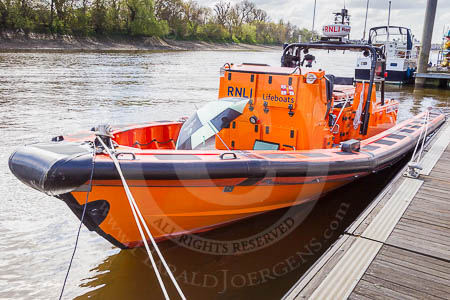Interactive Virtual Tour
RNLI E-Class Inshore Lifeboat
The intention behind these two combined interactive 360° panoramas is to show how state-of-the-art and spectacular a modern lifeboat can be.
There are lots of interactive elements viewers love playing with:
- All the controls, buttons, and switches are explained
- In many places, static photos are shown together with the explanations
- Viewers can see two operful engines by looking under their covers
- All lockers can be opened, their contents are explained and shown in static images
The really spectacular interactive elements are the sounds - all sounds together create a lot of noise:
- Both engines can be started and stopped individually
- There is a horn, a siren, and a fog horn that can be used
- A Chiswick Lifeboat / London Coast Guard radio check has been recorded
- On the foredeck, RNLI volunteer Holly talks about her work
The virtual tour is used on the RNLI website and on their Facebook page, and attracts large numbers of visitors, almost all of them spending some time to explore.

Customer
The client is the RNLI Chiswick, the Royal National Lifeboat Institution, based at Chiswick Pier in London, UK.
The RNLI, founded in 1824, is the largest charity that saves lives at sea and on some UK inland waterways like the Thames.
How it was done
All photography has been done with the camera remotely controlled via a laptop computer. The main challenges has been the boat movements and the tide:
With the camera in a fixed position to the boat, any boat movement meant a slight change of the scenario outside the boat. All the photos have to be stitched together, with only the boat itself as a usable reference. The tide meant a change of the height of the boat and the camera, so the view of anything outside the boat changed gradually.
To have every detail in focus, from the closest to the lens to the furthest (almost infinite), focus stacking has been used. All photography has been done with available light only, using exposure bracketing. The combination of focus stacking and exposure bracketing means a large number of photos: The cockpit section is based on around 800 21-megapixel RAW images,
The resulting photos have been processed using focus stacking software. The resulting images have been edited, then stitched together, edited again, and then turned into a spherical panorama.
The lifeboat
E0-9 "Brawn Challenge", an E-Class Mark II lifeboat, was built in 2012 by MST Marine Specialised Technology Liverpool as an Inshore Lifeboat (ILB).
The E class is the fastest lifeboat in the RNLI's fleet and is on service at only two lifeboat stations - Tower and Chiswick, on the River Thames. The E class has been specially designed to meet the demands of the Thames with its fast-running tide, powerful debris and heavy traffic. The fast response craft was developed for use with water jets that give it excellent manoeuvrability in the rapidly moving river flow. The equipment includes radar, GPS chart plotter, marine radio, police radio, blue lights, siren, night-vision equipment, first aid, oxygen, entonox, defibrillator. The E class features a working platform at the stern that makes it easier to recover survivors from the water. Powered by twin Volvo Penta 435hp diesels, and using Hamilton Water Jets, the E Class is limited to a speed of 42 knots (that's 48 mp/h, or 78 km/h).
The boat is 10.5m long, 3.5m wide, and has a draft of 0.7m. It has a crew of three, and can carry up to 20 survivors and a stretcher.
Credits
- Chiswick RNLI for their help in the photography stage of the project, and for providing all the explanations seen in the panora.
